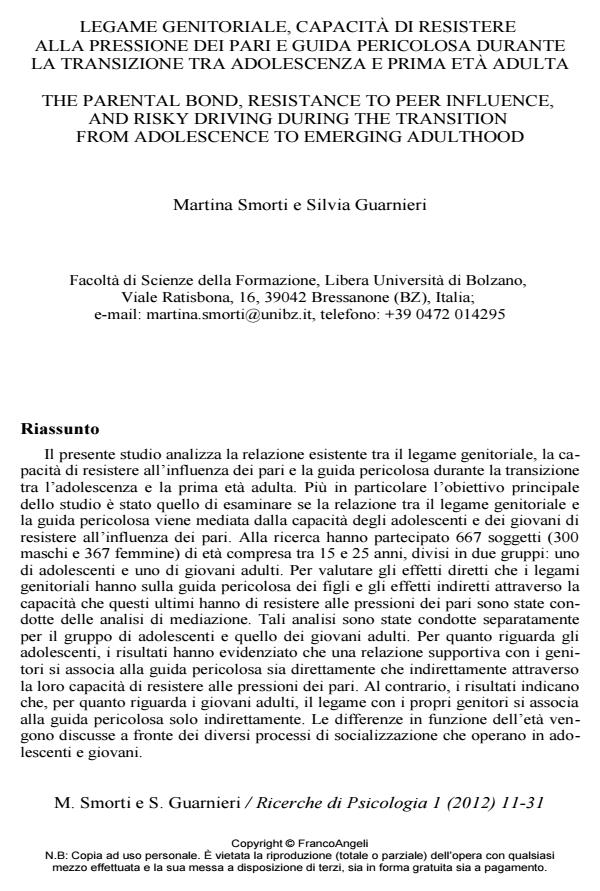Legame genitoriale, capacità di resistere alla pressione dei pari e guida pericolosa durante la transizione tra adolescenza e prima età adulta
Titolo Rivista RICERCHE DI PSICOLOGIA
Autori/Curatori Martina Smorti, Silvia Guarnieri
Anno di pubblicazione 2013 Fascicolo 2012/1
Lingua Italiano Numero pagine 21 P. 11-31 Dimensione file 673 KB
DOI 10.3280/RIP2012-001002
Il DOI è il codice a barre della proprietà intellettuale: per saperne di più
clicca qui
Qui sotto puoi vedere in anteprima la prima pagina di questo articolo.
Se questo articolo ti interessa, lo puoi acquistare (e scaricare in formato pdf) seguendo le facili indicazioni per acquistare il download credit. Acquista Download Credits per scaricare questo Articolo in formato PDF

FrancoAngeli è membro della Publishers International Linking Association, Inc (PILA)associazione indipendente e non profit per facilitare (attraverso i servizi tecnologici implementati da CrossRef.org) l’accesso degli studiosi ai contenuti digitali nelle pubblicazioni professionali e scientifiche
Il presente studio analizza la relazione esistente tra il legame genitoriale, la capacita di resistere all’influenza dei pari e la guida pericolosa durante la transizione tra l’adolescenza e la prima eta adulta. Piu in particolare l’obiettivo principale dello studio e stato quello di esaminare se la relazione tra il legame genitoriale e la guida pericolosa viene mediata dalla capacita degli adolescenti e dei giovani di resistere all’influenza dei pari. Alla ricerca hanno partecipato 667 soggetti (300 maschi e 367 femmine) di eta compresa tra 15 e 25 anni, divisi in due gruppi: uno di adolescenti e uno di giovani adulti. Per valutare gli effetti diretti che i legami genitoriali hanno sulla guida pericolosa dei figli e gli effetti indiretti attraverso la capacita che questi ultimi hanno di resistere alle pressioni dei pari sono state condotte delle analisi di mediazione. Tali analisi sono state condotte separatamente per il gruppo di adolescenti e quello dei giovani adulti. Per quanto riguarda gli adolescenti, i risultati hanno evidenziato che una relazione supportiva con i genitori si associa alla guida pericolosa sia direttamente che indirettamente attraverso la loro capacita di resistere alle pressioni dei pari. Al contrario, i risultati indicano che, per quanto riguarda i giovani adulti, il legame con i propri genitori si associa alla guida pericolosa solo indirettamente. Le differenze in funzione dell’eta vengono discusse a fronte dei diversi processi di socializzazione che operano in adolescenti e giovani.
Parole chiave:Legame genitoriale, influenza dei pari, guida pericolosa, differenze di eta
Martina Smorti, Silvia Guarnieri, Legame genitoriale, capacità di resistere alla pressione dei pari e guida pericolosa durante la transizione tra adolescenza e prima età adulta in "RICERCHE DI PSICOLOGIA " 1/2012, pp 11-31, DOI: 10.3280/RIP2012-001002